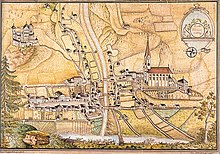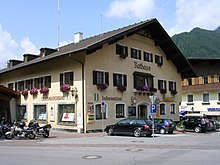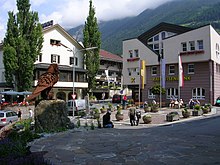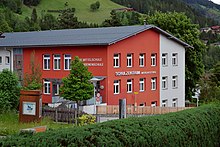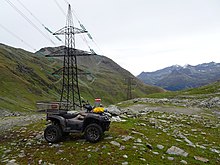Matrei in East Tyrol
|
market community Matrei in East Tyrol
|
||
|---|---|---|
| coat of arms | Austria map | |
|
|
||
| Basic data | ||
| Country: | Austria | |
| State : | Tyrol | |
| Political District : | Lienz | |
| License plate : | LZ | |
| Surface: | 277.94 km² | |
| Coordinates : | 47 ° 0 ′ N , 12 ° 32 ′ E | |
| Height : | 975 m above sea level A. | |
| Residents : | 4,651 (Jan 1, 2020) | |
| Postal code : | 9971 | |
| Area code : | 04875 | |
| Community code : | 7 07 17 | |
| NUTS region | AT333 | |
| Address of the municipal administration: |
Rauterplatz 1 9971 Matrei in East Tyrol |
|
| Website: | ||
| politics | ||
| Mayor : | Andreas Köll ( ÖVP ) | |
|
Municipal Council : (2010) (17 members) |
||
| Location of Matrei in East Tyrol in the Lienz district | ||
 Matrei with the parish church, consecrated in 1798 |
||
| Source: Municipal data from Statistics Austria | ||
Matrei in Osttirol (until the 20th century: Windisch-Matrei , often abbreviated Matrei i. O. ) is a market town with 4651 inhabitants (as of January 1, 2020) in the district of Lienz (East Tyrol) in Austria and with a size of 277, 8 km² the second largest municipality in Tyrol . The municipal area extends over the entire Tauern valley and parts of the upper Isel valley . The Matrei market itself is located about 29 km north of Lienz at the confluence of the Tauernbach in the Isel and is the economic, social, tourist and medical center for the northern part of the district. Economically, tourism occupies an outstanding position in the municipality, whereby, in contrast to large parts of East Tyrol, a more important winter tourism has been able to establish itself here. Furthermore, the population is mainly employed in small and medium-sized enterprises or in agriculture.
geography
location
Matrei is the largest municipality in East Tyrol and is located in the north of the Lienz district. The municipality includes the high mountain landscape of the Hohe Tauern with the Tauern valley and its side valleys ( Frosnitz valley , Landeggtal , Gschlößtal ) and the upper Isel valley . The municipality includes parts of the Venediger group and the Granatspitz group with a multitude of mountains over 3000 m altitude. The highest point of the municipality is the Großvenediger ( 3657 m above sea level ), the lowest point of the municipality is located at 814 m in the village of Huben.
Community structure
The community of Matrei in Osttirol consists of two cadastral communities , the cadastral community of Matrei in Osttirol Markt with the town of Matrei itself and the cadastral community of Matrei in Osttirol Land .
Matrei in Osttirol Land includes:
- in the upper Iseltal (from north to south) the villages of Kienburg , Huben , Moos , Feld, Mattersberg , Klausen , Seblas
- in the vicinity of Matrei (starting from the northeast in a clockwise direction) the villages of Glanz , Hinterburg , Klaunz , Bichl , Waier and Ganz
- in the lower Virgental the village of Zedlach
- in the Tauern valley (from south to north) the villages of Kaltenhaus (with the hamlet of Stein), Prossegg , Hinteregg , Gruben , Berg , Raneburg and Tauer
|
structure
|
||||||
|
Legend for the breakdown table
|
Land use
| Land and land use | |||
|---|---|---|---|
| Soil type | Size (ha) | % | |
| wasteland | 12,300 | 43.9 | |
| Alpine pastures and mountain meadows | 7,500 | 26.8 | |
| Forest | 5,200 | 18.6 | |
| Meadows and farmland | 1,200 | 4.3 | |
| Unused grassland | 1,000 | 3.6 | |
| Pastures | 500 | 1.8 | |
| Waters | 160 | 0.6 | |
| Traffic areas | 140 | 0.5 | |
The municipality of Matrei in East Tyrol covers around 27,800 hectares. Due to the high alpine location and the large proportion of the Hohe Tauern , large parts of the area cannot be used, which is why around 44% of the municipality area is wasteland . In second place are alpine pastures and mountain meadows , which make up about 27% of the municipal area. Also forests play an important role in the municipality of Matrei. At around 19%, this type of use is in third place. All other surface forms play a relatively minor role proportionally. Meadows comprise 4.3%, unused grassland 3.6% and pastures 1.8% of the municipal area. Waters and traffic areas account for only 0.6% and 0.5%, respectively.
Neighboring communities
| Neukirchen am Großvenediger |
Bramberg / Hollersbach |
Mittersill / Uttendorf |
|
Pregraten / Virgen |

|
Kals am Großglockner |
| Sankt Veit in Defereggen | Hopfgarten in Defereggen | Sankt Johann im Walde |
geology
Matrei is located on the inside of the Alpine arc or the south side of the Hohe Tauern , which means that the main rock of the Matrei mountain landscape consists mainly of gneiss and slate granite . The ridge and core of the mountains are formed by the Tauern window . The central gneiss of the Tauern window is encased in a slate shell. This slate shell is formed in the lower part of the northern municipal area by lime-poor or lime-free rocks, in particular mica slate with garnets , dark phyllites , light quartzites , white marble features and dark horn blends. To the south of this, this lower shell is followed by an upper or outer shell several kilometers wide, which extends from Raneburg in the Tauern valley to Matrei. It consists of calcareous rock such as yellowish and brown weathered limestone mica schist and limestone phyllites, which appear in the board wall and on the Ochsenbug as steeply erected plates ("boards"). Matrei itself lies in the so-called Matreier Zone , a narrow series of different rocks that extends east from Kals through the Virgen Valley to the west. The zone consists of phyllitic stones, gypsum , quartzite, light dolomite and dark limestone , yellowish-brown Rauhwacken , breccias as well as gneiss and green slate. To the south of Matrei, in the Iseltal valley, there is finally a zone of old crystalline made of light mica gneiss and slate with transition zones to slate gneiss and phyllites ( Zunig , Roter Kogel).
mountains
Due to its location within the Hohe Tauern, the municipality of Matreis is characterized by the numerous mountains. The highest elevations are in the Matrei share in the Venediger group . The highest point is the Großvenediger ( 3657 m ), followed by the mountain range in the east with the Rainerhorn ( 3559 m ), the Black Wall ( 3503 m ), the Hohen Zaun ( 3451 m ) and the Kristallwand ( 3310 m ) and in the south following the Weißspitze ( 3300 m ) and the Hohe Eichham ( 3371 m ). The Venediger group is also partly heavily glaciated in the Matreier municipality. Thus, in the valley of Gschlößtals with the Schlatenkees the second largest glacier in the Venedigergruppe.
In addition to the Venediger group, the municipality of Matreis also includes around half of the Granatspitz group and a small portion of the Villgraten mountains . The highest elevations of the two mountain groups are in Matrei's municipal area the Great Muntanitz ( 3232 m ) and the Great Zunig ( 2776 m ). The latter is also considered a local mountain of the Matreier, other important local mountains of the Matreier are the Kristallkopf or Ochsenbug ( 3007 m ) and the Bretterwandspitze ( 2868 m ).
Rivers

The 18-kilometer-long Tauernbach in the Tauern Valley is the determining body of water in the municipality . In addition, there are its most important tributaries in the upper reaches, the Gschlößbach in the Gschlößtal, the Landeggbach and the Frosnitzbach . In the lower reaches of the Tauernbach takes on the Steiner Bach (with the famous Steiner waterfall ) and then flows through the Proseggklamm, which was made accessible by a hiking trail at the beginning of the 20th century. The determining river for the Matrei market itself is the Bretterwandbach . In 1346 he completely destroyed the place and later devastated it several times. For a long time, it was considered one of the most dangerous torrents in Austria. However, it has now been defused by massive barriers. Below Matrei, the Tauernbach flows into the Isel , which characterizes the southern municipality. The river valley has varied formations there and is accompanied by the Iseltalstraße and a cycle path.
In the Landeck valley, some streams are fed to the Stubachtal power plant group .
history
Matrei to the Middle Ages
The first archaeological finds in the area of Matreis are from the early and middle Bronze Age (around 22nd to 13th centuries BC). At Matreier Klaunzerberg there was a melting point from the Bronze Age, where ceramic finds were made. There are later finds from the younger Iron Age , where typical ceramics of that time with shallowly painted or stamped patterns were unearthed near Matrei (Weißenstein). Around 100 BC The East Tyrolean area fell to the Celts , with whom the Roman Empire concluded a state friendship treaty. When East Tyrol and Matrei finally fell under the Roman Empire, the place played an important role as a starting point in the copper-rich Virgental and as the intersection of the mule track over the Felber Tauern.
Matrei in the Middle Ages
After the fall of the Roman Empire, the Matreier area was settled by the Alpine Slavs and incorporated into the Slavic empire of Carantania . In the 8th century, however, the Slavic Empire came under the Duchy of Bavaria and was settled and Christianized by Bavarian colonists . In 811 the Archdiocese of Salzburg asserted itself as the diocesan ruler, but in the Middle Ages, Matrei initially belonged to the Carinthian Lurngau . After a phase as a count's manorial rule, the Salzburg archbishopric gained control of the Matrei area in 1212. However, due to the affiliation to Salzburg, the Windisch-Matrei nursing court was pushed into a marginal position, as it had been isolated from the surrounding areas. In the second half of the 13th century at the latest , Matrei also received market rights and Salzburg established a Salzburg original parish in Matrei . As a result, Salzburg also provided the largest landowner in Matrei. In the middle of the 13th century there was a dispute between Philipp von Spanheim , Archbishop of Salzburg, and Count Meinhard III. von Gorizia several times to devastation of the Matreier area, in 1252 the conflict was settled by the peace of Lieserhofen .
Matrei in the early modern period
Around 1616 there were 30 town houses in the Matrei market and agriculture remained the livelihood of the market place in the early modern period . In 1592 there were only 18 craftsmen and traders in the village who were organized according to guilds . Other sources of income were ore mining, transport and seasonal work in summer.
Triggered by massive tax increases at the beginning of the 16th century, peasant revolts broke out in Tyrol and Salzburg , in which the Matreians also took part in 1525. As a result, Matrei fell to Tyrol at short notice. From the middle of the 16th century, Matrei was repeatedly shaken by strong outbreaks of the plague and other epidemics . In addition, arbitrary tax increases repeatedly caused uprisings in the 17th century. The biggest uprising, however, came at the time of the War of the Spanish Succession . The Little Ice Age , the decline of ore mining and the mudslide of the place made the population impoverished. As a result, there was also a dispute with the Salzburg cathedral provost in 1703 , as the Matrei citizens were unable to pay the required taxes.
Matrei in the 18th and 19th centuries
The most important event for the Matreians from the middle of the 18th century onwards was the construction of the rectory and the parish church of St. Alban . In the course of the Napoleonic Wars , the Matreier took part in the Tyrolean defense against the French invasion in 1797. When Salzburg fell to the new Austrian Empire in 1805, Matrei became part of Austria. Tyrol, however, became Bavarian in 1805 and in 1809 Salzburg also fell to Bavaria after Austria's defeat. After the defeat of the Tyroleans on the Bergisel , the French also advanced into East Tyrol, occupied Matrei on December 24th and awarded it to the newly created Illyrian provinces in 1811 . In 1813 the rule of the French ended and Emperor Franz I ordered the unification of Windisch-Matreis with Tyrol.
The annexation of Matreis to Tyrol brought about a gradual liberation of the farmers and in 1817 a new division of the communities followed, which essentially reflects the current situation. However, the newly created communities of Windisch-Matrei-Markt and Windisch-Matrei-Land were only merged in 1938. Around 1860 the livelihood of the Matrei population was still based almost exclusively on agriculture. A local chronicle says that the Middle Ages did not end in Matrei until the 19th century. In addition to the general modernization in Austria, another reason was the incipient mountain tourism, which was added as a new source of income. Overall, however, the economic situation had not changed significantly in the second half of the 19th century. In addition to everyday needs, there were also serious catastrophes at the end of the 19th century. First, the village of Bichl burned down in 1895, and in the same year the Bretterwandbach devastated Matrei. In 1897 almost the entire market was destroyed by flames.
Matrei from the 20th century
Since a railway line through the Felbertauern was discarded in favor of the Mallnitz - Bad Gastein ( Tauernbahn ) railway project and a local railway from Lienz, road construction was promoted to promote tourism. In the political arena, the dominance of conservative parties was retained after the First World War , but the Social Democrats were unable to gain a foothold in Matrei. At the beginning of the 1930s, however, the National Socialists were able to gain some popularity. From an economic point of view, tourism became more and more important in the interwar period, but there was no further upswing due to the lack of Felbertauernstrasse and the thousand-mark block . After Hitler came to power in Germany and the " Anschluss of Austria ", illegal National Socialists and new party members took power. The planned amalgamation of the market town with the rural community was decided in 1938, but East Tyrol came at the same time to the Gau Carinthia. During the surrender of the Wehrmacht , the first Allied soldiers arrived on May 8, 1945 .
The ÖVP has dominated politically since 1945 . The annexation of East Tyrol to Carinthia was reversed in 1947. Tourism experienced a boom as early as 1948, and in the 1950s it was also possible for the first time to increase winter tourism in Matrei. The construction of the Felbertauern Straße including the Felbertauern tunnel (completed in 1967) and the general tourism boom in the 1960s increased the importance of tourism in Matrei. After the opening of the Goldried ski area, sustained successes were also achieved in winter tourism. With the establishment of the Hohe Tauern National Park , the forerunners of which go back to the 19th century via the Alpine associations, the goal was directed towards gentle tourism, which is endangered by the planned Matrei-Raneburg pumped storage power station . In addition to the local population, who have organized themselves in a citizens' initiative, the district parties Greens , the SPÖ and the FPÖ are speaking out against the planned power plant.
population
| Population distribution 2011 | |||||
|---|---|---|---|---|---|
| Places over 100 Ew. |
Places under 100 Ew. |
||||
| Matrei (market) | 2,439 | Kienburg | 95 | ||
| Waier | 243 | Mattersberg | 85 | ||
| Hinterburg | 231 | shine | 73 | ||
| Bichl | 213 | field | 63 | ||
| Huben | 172 | Klausen | 59 | ||
| Klaunz | 166 | mountain | 40 | ||
| Prossegg | 149 | Pits | 26th | ||
| Zedlach | 146 | Raneburg | 18th | ||
| moss | 144 | Hinteregg | 11 | ||
| All | 135 | Dew | 9 | ||
| Cold house | 126 | ||||
| Seblas | 109 | ||||
Population development
From 1869 to the 1920s , the population decreased or stagnated. Since the 1923 census , steady increases have been recorded, including between the last two censuses in 1991 and 2001 by 8.4%. A slightly negative balance of migration is offset by a positive birth balance. By 2003 there was a further increase to 4913 inhabitants.

Population structure
The distribution between the female and male population in the municipality of Matrei is almost even. Compared to Tyrol as a whole , the proportion of the male population is significantly higher, as the proportion of the female population in the federal state is 2.5% higher than the male population. Compared with the Tyrol both the younger and the older population has a higher percentage of Matrei, possibly a reference to the professional swinging out numerous Matreier. There are hardly any foreigners in the municipality, around 98% of the population are Austrian citizens . Around 2% come from an EU country (EU-15). There are also only a few naturalized people in the municipality; almost 97% of the resident population were born in Austria. Around 97% of the population of Matrei is almost exclusively Roman Catholic , another 1.6% are of Protestant faith.
politics
In the 2004 municipal council elections, the ÖVP- related list Together for Matrei under Mayor Andreas Köll received 54.6% of the votes (10 seats). Second place in the elections went to the list for work and business with 17.7% (3 seats), ahead of the Independent Community List Matrei (UGM) with 13.7% (2 seats). The Green and Independent List Matrei (GUM) each won one mandate with 8.7% and the List FPÖ and Independents for Matrei with 5.3%. Compared to the municipal council elections of 1998, the mayor's list increased by around 6%, while the UGM lost half of its share of the vote, while the FPÖ list was only able to gain a third of its share of the vote. All the others were running for the first time. How strongly the ÖVP is anchored in Matrei can be seen from a look at the state elections of 2003, where it achieved 73.99% of the vote.
coat of arms
The municipal coat of arms of Matreis was awarded in 1691 by the Salzburg cathedral provost. A martyr is shown on a yellow background with a sword in his left hand and his severed head in his right. However, Alban of England (recognizable by his Roman soldiers' clothing) and not Alban of Mainz is incorrectly shown on the municipal coat of arms . Alban von Mainz is the actual namesake of the parish church.
Due to the efforts of the community, the coat of arms now shows an additional head on Alban's torso so that it is no longer mocked as "headless".
Economy and Infrastructure
For the economic history and the history of the school system see: History of Matreis in Osttirol
tourism
Tourism became an important economic factor in Matrei, especially after the Second World War. In contrast to many other parts of East Tyrol, the municipality has a significant proportion of winter nights thanks to the Goldried ski area, which was opened up in the early 1980s . In 1998, investments were made in a new monocable gondola. The most important mainstay, however, is summer tourism, which was steered in a gentle direction with the establishment of the Hohe Tauern National Park . In addition to hiking (over 150 three-thousand-meter peaks), Matrei is also popular with fly fishermen (Isel, Tauernbach), ice climbers (Tauern and Iseltal) and cyclists (Iseltal cycle path). Matrei also has an outdoor pool , a riding and tennis hall, a mini golf course and a regional climbing center with a climbing hall. Currently, around 260,000 to 300,000 overnight stays are counted per year.
Industry, trade and commerce
Within the market area of Matrei there are numerous craft and trading companies, four banks and an industrial company with more than 200 employees. The grocery trade, on the other hand, has shifted from the center to the outskirts due to the parking lot situation. Further companies have settled in the cadastral community of Matrei-Land, particularly in the Seblas commercial and industrial area. These include a metal goods factory (Tschojer Stahl), a heating system manufacturer as well as transport companies, cable car builders, a carpentry and other businesses. There are other small and medium-sized businesses in the localities, fractions and hamlets.
Agriculture
After the Second World War, Matreis agriculture underwent profound changes. Between 1961 and 1977 the proportion of the rural population fell from 40.1% to 19.8%. The cultivation of grain was practically given up. While pig, poultry and goat farming has been declining continuously since the early 19th century, cattle farming has increased, in particular due to growing farm sizes. Sheep breeding, on the other hand, experienced ups and downs, which, after a sharp decline in the middle of the 20th century, recorded growth again. In 1995 there were still 66 full-time farms, 75 part-time farms and 165 part-time farms in Matrei, the most important form of farming being cattle breeding and alpine farming playing an important role in the northern municipality. The size of the farms today averages 10 to 15 large cattle.
education
In the village of Matrei there is a school center whose catchment area includes the entire northern region of East Tyrol. The school center houses a primary school, a new middle school (formerly a secondary school), a general special school with a special educational center, a polytechnic school with workshops for metal and mechatronics, and an adult school. There are other elementary schools in the municipality in Huben and Zedlach . The state music school Matrei-Iseltal is also located in the village.
Transport and infrastructure

The most important traffic connection for the municipality of Matrei is the Felbertauernstraße B 108, which connects Matrei to the north via the toll-based Felbertauern tunnel with Mittersill (Salzburg) and to the south-east with Lienz. An annual average of around 3,500 vehicles enter the municipality via the Felbertauern tunnel. The Felbertauernstraße also forms the most important connection to the neighboring valleys, with which Matrei is connected by the connections to Virgental -Landesstraße L 24, Defereggentalstraße L 25 and Kalser Straße .
Matrei can only be reached publicly by postbus . Line 4412 connects the municipality up to eleven times a day to the district capital Lienz and continues into Virgental to Prägraten am Großvenediger . Line 4414 also runs from Lienz via Felbertauernstraße in the direction of Matrei, but branches off at Huben into Defereggental and reaches St. Jakob up to eight times a day . Line 4408 also runs from Lienz via Huben to Kals am Großglockner .
In addition to the traffic infrastructure, two important energy supply lines also run through the municipality. On the one hand this is the Transalpine Oil Line (TAL) Trieste - Ingolstadt , on the other hand the 380 kV high voltage line Kaprun- Lienz. Both are led to Salzburg via the Tauern Valley.
Culture and sights
Attractions
The most important sights in the municipality of Matrei are the numerous churches and chapels, including the classical Matrei parish church , the Romanesque St. Nicholas Church and the unusual rock chapel in the Gschlößtal . The town of Huben also has a larger church with the Sacred Heart Church. In total there are 41 churches, chapels and wayside shrines in the municipality . With the “Medaria” museum, Matrei also has its own local museum with an exhibition of objects of daily use and a collection of minerals.
Visual arts
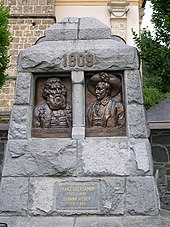
Some important sculptors were born in Matrei, some of whom also worked here. Johann Paterer, for example, created a figure for the Matreier parish church, Joseph Mattersberger mainly worked abroad. Also Jakob Wibmer presented some sculptures ago, gained its artistic significance, however, as well as Franzburger through painting. The best-known visual artist Matreis is Virgil Rainer , born as the son of the sacristan of St. Nicholas Church , who became known for his large-scale sculptures. Rainer also created religious works for numerous Tyrolean churches and war memorials for the years 1809 and 1918. Among them is the memorial for the freedom fighters Johann Panzl and Anton Wallner in front of the Matrei local cemetery. Other works of art by Rainer in Matrei are the praying savior at his father's grave, the plaster relief Death of Saint Joseph in the old people's home chapel and the relief Theresia von Lisieux and the processional figures of St. Antonius , St. Notburga , St. Alban and the Mother of God in the parish church . The matreier Fritz Tiefenthaler also became known through various works. He worked with Clemens Holzmeister and designed not only monuments and churches but also some coins for the Austrian Mint . In Matrei itself, Tiefenthaler immortalized himself, among other things, with a relief wall on the school building, a memorial on Felbertauernstrasse and a ceramic work at the Sparkasse.
music
In Matrei, folk music and folk music in particular dominate . The Goldried Quintet and the Matrei Viergesang became particularly well known beyond Matrei. In addition, the community also has two music bands in Matrei and Huben, which organize concerts several times for locals and tourists during the summer months.
Sports
With the Sportunion Matrei, the municipality has a large club with the sections football, tennis, judo, Ranggeln , ski, stick shooting, gymnastics and running. Union Matrei football club currently plays in the Carinthian League and plays its home games in the local, newly built Tauern Stadium. The highest division ever reached was the Carinthian regional league. The Tauern Stadium offers 1000 covered seats, a video wall and an artificial turf training area. Next to the old Tauern Stadium there is also a riding and tennis hall. The ski section also organized FIS races in the 1990s . Huben also has its own sports club, Sportunion Huben, with the sections football, tennis, gymnastics, tobogganing, as well as alpine and Nordic skiing. Particular attention is paid, however, to the ice hockey club UECR Huben, which is currently active in the Carinthian Hockey League (the Carinthian State League and the Carinthian Eliteliga have been combined). In the 2005/06 season, the runner-up title in the Carinthian regional league was achieved. The highest division ever reached was the Carinthian Eliteliga, which was won in the 1999/2000 season. Ice hockey games are played on the local ice rink in Huben.
science
The Matreier Talks have been held every December since 1976. This international scientific conference was of Otto Koenig launched to kulturethologische research to promote. It offers scientists from disciplines as diverse as physics, chemistry, mathematics, history, musicology, education, biology, sociology, theology, ethnology and psychology an interdisciplinary platform to discuss cultural ethological implications of selected topics.
Other associations
In addition to the associations already mentioned, Matrei has a wide range of associations. The most important associations are the national rifle company , the volunteer fire brigade in Matrei and Huben, the Matrei in Osttirol section of the Alpine Association , the mountain rescue service , the Red Cross , the Medaria Local History Association and numerous other choirs, music and dance groups.
Personalities
- Joseph Mattersberger (1754–1825), sculptor
- Simon Stampfer (1790–1864), mathematician
- Johann von Lasser (1822–1889), Abbot of Lambach
- Engelbert Kobald (1848–1926), physicist and mathematician
- Virgil Rainer (1871–1948), sculptor
- Josef Brugger (* 1953), politician
- Alois Mattersberger (* 1961), cook
- Lydia Marinelli (1965–2008), historian , curator and exhibition organizer , specializing in the history of psychoanalysis
- Elisabeth Mattersberger (* 1965), politician, deputy mayor and member of the Federal Council
- Alexander Köll (* 1990), Austrian-Swedish ski racer
literature
- Michael Forcher (Red.), Anton Draxl (Articles): Matrei in Osttirol. A parish book for the 700th anniversary of the first mention as a market. 1280-1980 . Tyrolia, Innsbruck 1980.
- Catholic Tyrolean Teachers' Association (Ed.): District Studies East Tyrol . Edition Löwenzahn, Innsbruck 2001, ISBN 3-7066-2267-X .
Web links
- Community website
- 70717 - Matrei in East Tyrol. Community data, Statistics Austria .
- Latest news about Matrei
- Tourist information Matrei in Osttirol
- Archive recordings from and about Matrei in the online archive of the Austrian Media Library (folkloric films, radio reports)
Individual evidence
- ↑ Excerpt from the water book. In: portal.tirol.gv.at. Retrieved October 3, 2016 .
- ↑ L. Z .: Electric Railway Lienz – Windisch-Matrei. In: Communications from the German and Austrian Alpine Club , year 1898 (Volume XXIV), p. 142, center right. (Online at ALO ).
- ^ Matrei in Osttirol: Population by locality , register census 2011
- ↑ Tiroler Tageszeitung - Of Headless Martyrs and Matreier Eggs
- ↑ Matreier calls - kulturethologische meeting , accessed December 2, 2011








